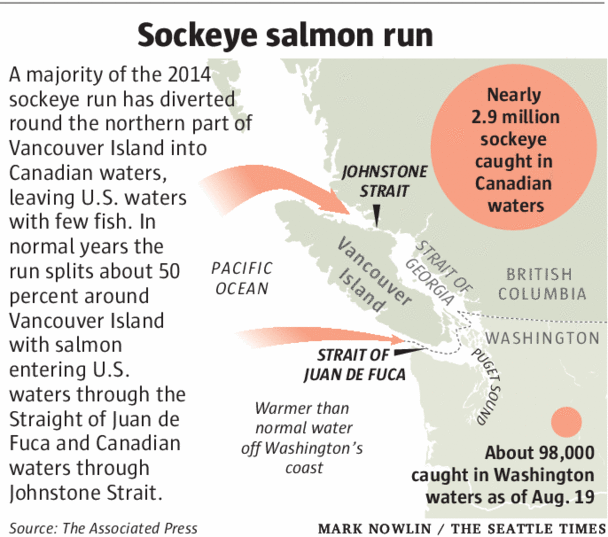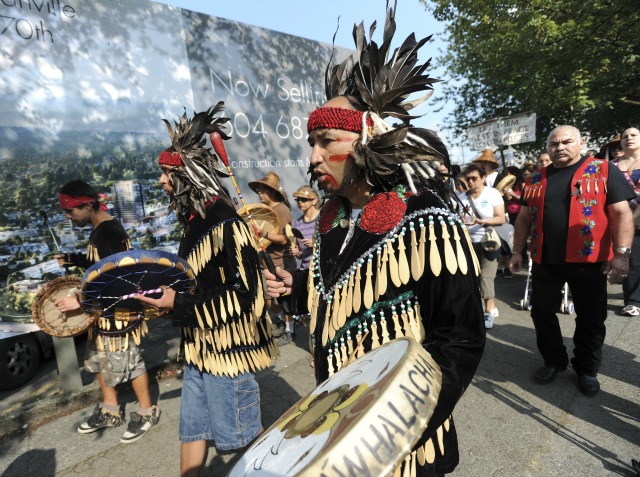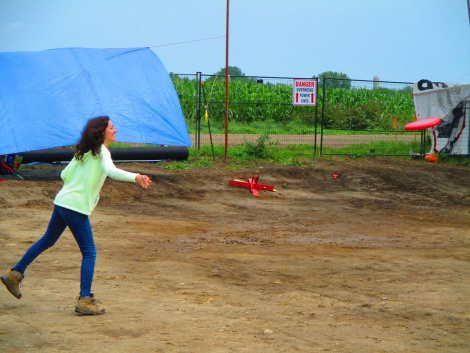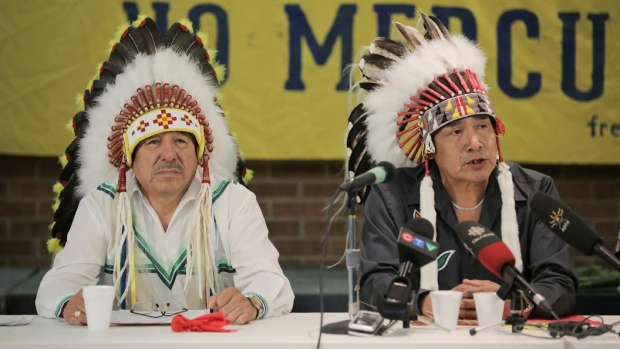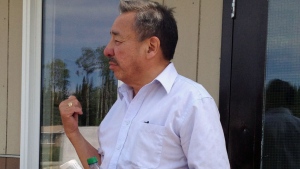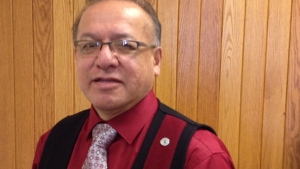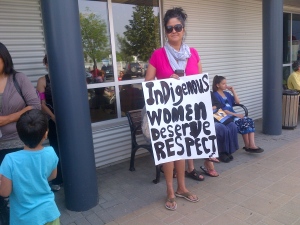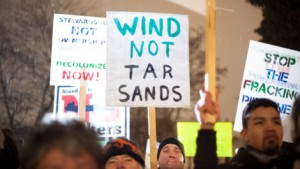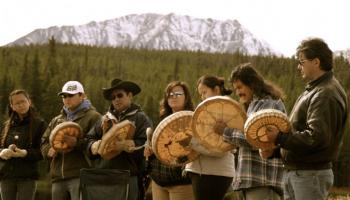The millions of cubic metres of water that poured out of Mount Polley mine when the dam collapsed had failed provincial water quality guidelines for human and aquatic health in the past, according to the B.C. environment ministry and early Wednesday the Cariboo Regional District declared a state of local emergency.
Data sent to the ministry by Mount Polley as recently as Monday showed that selenium concentration exceeded drinking water guidelines by a factor of 2.8 times.
There have also been drinking water exceedances of sulphate over the last few years, according to information supplied to The Vancouver Sun by environment ministry spokesman Dave Crebo.
Aquatic water guidelines have also been exceeded in the past for nitrate, cadmium, copper and iron.
Al Richmond, of the Cariboo Regional District, said water tests were being expedited and results are expected by Thursday.
The Regional District declared a state of local emergency early Wednesday. The move will allow access to additional resources that may be needed to further protect the private property and government infrastructure in Likely.
The release of 10 million cubic metres of water — enough to fill B.C. Place more than four times — is also potentially contaminated with toxic metals such as arsenic and mercury, a concern for hundreds of area residents’ water supply and important salmon habitat.
According to 2013 data the company released to Environment Canada on disposal of chemicals, Mount Polley mine disposed of almost 84,000 kilograms of arsenic and its compounds through tailings last year, as well as about 1,000 kg of cadmium, 38,000 kg of lead and 562 kg of mercury.
Mount Polley, operated by Imperial Metals, is an open-pit copper and gold mine with a four-kilometre-wide tailings pond built with an earthen dam located in central B.C., west of Williams Lake and near the community of Likely.
Provincial officials are conducting tests of water samples from the area. Until results come back, the severity of the contamination remains unknown and a drinking water ban remains in effect for about 300 people in the immediate vicinity.
Imperial Metals president Bryan Kynoch apologized to Likely-area residents gathered at a community hall Tuesday afternoon, and said the company would do all it could to make right the effects of the dam collapse. “I know it’s going to take a long time to earn the community’s trust back,” he said. “This is a gut-wrenching experience, I know for you, but I can assure you it is for me.”

THE CANADIAN PRESS/Jonathan HaywardA aerial view shows the debris going into Quesnel Lake caused by a tailings pond breach near the town of Likely, B.C. Tuesday, August, 5, 2014. The pond which stores toxic waste from the Mount Polley Mine had its dam break on Monday spilling its contents into the Hazeltine Creek causing a wide water-use ban in the area.
Making it right includes reclaiming the environment, but also compensating in areas such as potential tourism business losses, he said.
More than 150 townspeople crowded into the hall to hear from Kynoch, provincial Mines Minister Bill Bennett and regional district officials.
Kynoch said he did not know why the dam collapsed, but acknowledged it is not supposed to happen.
He said he believed there was not likely to be danger to people, fish and animals.
Asked if he would drink the water, Kynoch shot back: “Yes, I’d drink the water.”
The company would soon have boats in the water to ensure that the debris did not reach the bridge in the community, Kynoch added.
He said he couldn’t say whether the mine would reopen, but noted that he would do all in his power to ensure it did.
Al McMillan and Judy Siemens were skeptical about Kynoch’s assurances there was likely to be no serious effects from the tailings spill. They and their pets are suffering from the water ban, and are concerned the slurry spilled into Hazeltine Creek will pose a problem over time, as it could bleed into the lake during rains.
McMillan took his aluminum boat to view where the creek spilled debris into the lake, and said the water made a sizzling, fizzing sound similar to when a pop is opened, which he believes were substances in the water reacting to his boat.
“I’ve seen five or six fish float by my dock, and a family of otters were feeding on them. What’s going to be the effect on them?” he asked.
Anthony Mack of the Xatsull First Nation spoke up at the meeting, questioning Kynoch’s belief the tests would show the environment was not harmed. In an interview, he said they will be conducting their own tests. “We do not trust industry or government,” said Mack.
Imperial Metals said early water tests are encouraging, with no mercury detected and arsenic levels about one-fifth of drinking water quality.
Suspended in the water is another 4.5 million cubic metres of fine sand, which contains the heavy metals.
Of these, the most hazardous to human and environmental health are arsenic, cadmium, copper, lead and mercury, said John Werring, senior science and policy adviser at the David Suzuki Foundation.
These are materials that are deemed “priority pollutants” by Environment Canada because they are known to be toxic, cause cancer, birth defects or genetic mutations and accumulate up the food chain, he said. Mercury and lead affect the nervous system.
“Understand that this stuff is washing into a big lake and it will dilute, but as it’s closer to the source, depending on the concentration of those chemicals, they can be lethal. It would be less lethal but still harmful the farther away you go and the longer it is put into the environment, there’s a greater opportunity that over time, the food chain will absorb it.”
The same applies to highly toxic non-metallic chemicals present in tailings that are used to separate metals during the mining process, but companies are not required to report amounts of these substances to Environment Canada, Werring said.
“These chemicals are there and I highly doubt that even now with the kind of water quality testing that’s going to be undertaken … they’re not even going to look for those.”
This is a serious incident that should not have happened
The cause of the breach, which occurred at 3:45 a.m. Monday, remains unknown. Mine personnel and instruments detected no indication of an impending breach, according to a statement from Imperial Metals.
Officials from the provincial Ministry of Energy and Mines are investigating the site at Mount Polley, Energy and Mines Minister Bill Bennett said in a statement Tuesday.
“This is a serious incident that should not have happened,” Bennett said Tuesday. “We are devoting every appropriate resource working with local officials to clean up the site, mitigate any impacts to communities and the environment, and investigate the cause of the breach. We will determine the cause of the event and we are determined to prevent an incident like this from happening again.”
In an interview in Likely, where Bennett spoke to the community, he said the last dam inspection was in September 2013. They also took a look at the dam’s water levels in May when the water was high, but found no problems, he said. “They’ve been in compliance,” said Bennett.
He said he expected to get water samples back in a day or two, which would be shared with the public.
The comprehensive investigation of the collapse would take longer, noted Bennett.

THE CANADIAN PRESS/HO, Cariboo Regional DistrictThe tailings pond of the Mount Polley mine, southeast of Quesnel, was breached, discharging waste water into Hazeltine Creek (shown ) on Monday, Aug. 4, 2014.
There remains a complete ban on drinking, swimming and bathing in the waterways surrounding the mine, including Polley Lake, Quesnel Lake, Cariboo Creek, Hazeltine Creek and the entire Quesnel and Cariboo Rivers systems right to the Fraser River.
The ban does not apply to people in Williams Lake or other towns along the Fraser.
Residents have been told not to allow pets or livestock to drink the water.
Likely resident Doug Watt said Tuesday that he was just starting to see the first debris from the breach float by his home on Quesnel Lake, where he gets all his drinking water.
Watt, whose water supply was cut off while his son, daughter-in-law and two small grandchildren were visiting on the weekend, stockpiled water from the lake as soon as they heard about the breach, knowing it would take several hours before any contaminants reached their area.
“We just filled up all sorts of containers.”
Watt said he is frustrated by a lack of information about water quality and availability. The first formal notice he received from authorities was a paper notice from the Cariboo Regional District taped to his door Tuesday morning warning people not to drink the water and directing them to the district’s Facebook page for more information, “which is fine if you have Internet. Many people don’t,” he said, noting that his Internet is unreliable.
“There’s a lot of confusion and I think a lot of people are very scared. People that are working at the mine have mortgages and kids to feed. They’re wondering what’s going to happen now … we can’t drink the water, but they don’t have the money to go buy the water.”
Important fish and wildlife habitat alongside Hazeltine Creek has been destroyed by the spill and is unlikely to recover as the fine sediment settles into the ground, Werring said. The full environmental impact won’t be known for decades, as animals that graze on any vegetation that grows back in the contaminated area will also be affected and the effects of toxins such as mercury is amplified as it accumulates up the food chain over time, he pointed out.
“Over a lengthy period of time, we can see long-term metal contamination of fish and wildlife in that area.”
We can see long-term metal contamination of fish and wildlife in that area
Consultants hired by local First Nations and mine owner Imperial Metals raised flags about the capacity of the tailings ponds as far back as 2011.
“The tailings pond was filling out and they needed to get rid of the water,” said consultant Brian Olding of the dam, which he described as “earthen.” “The walls were getting too high and the water was getting too high.”
In 2009, the mine applied to the B.C. Environment Ministry for a permit to discharge effluent into Hazeltine Creek. An amended permit was approved in 2012.
Watt, who worked at the mine as a metallurgist and shift supervisor nine years ago, said there were problems with the tailings ponds overflowing as recently as last winter, but the overflow was contained in retaining pools.
Werring, who is familiar with the environmental assessment process for mines, said tailings can be more safely managed by dehydrating them to make bricks, and then stacking them in such a way that water flow can be managed through them.
“It’s more expensive and it’s typically always written off,” he said.

